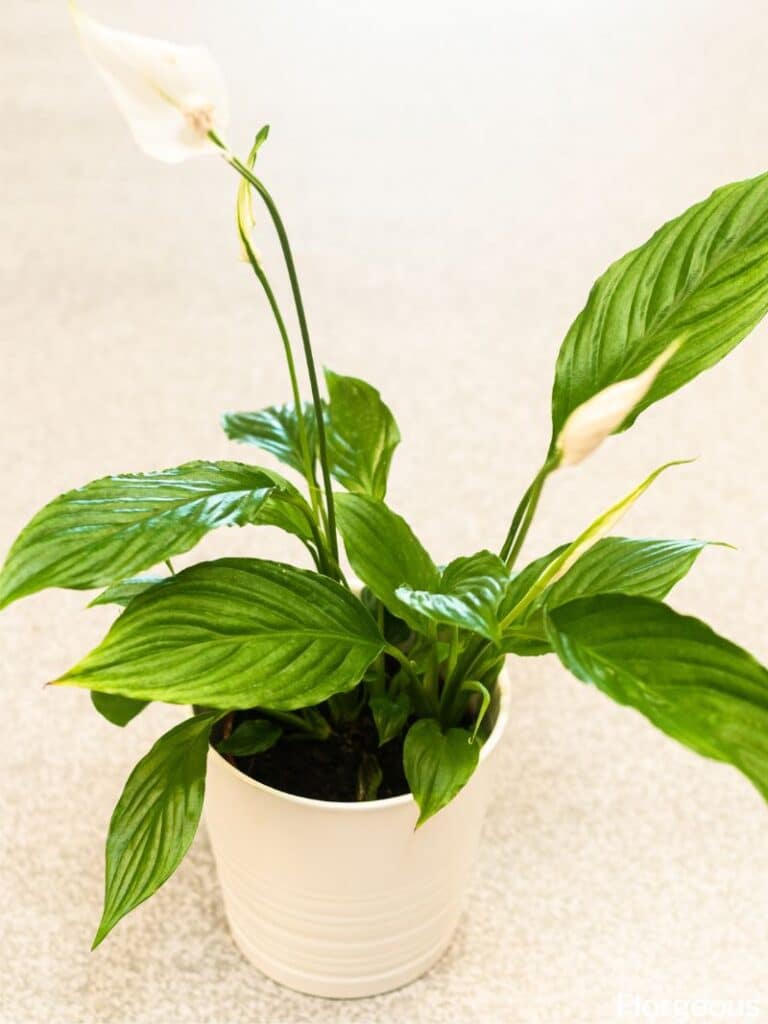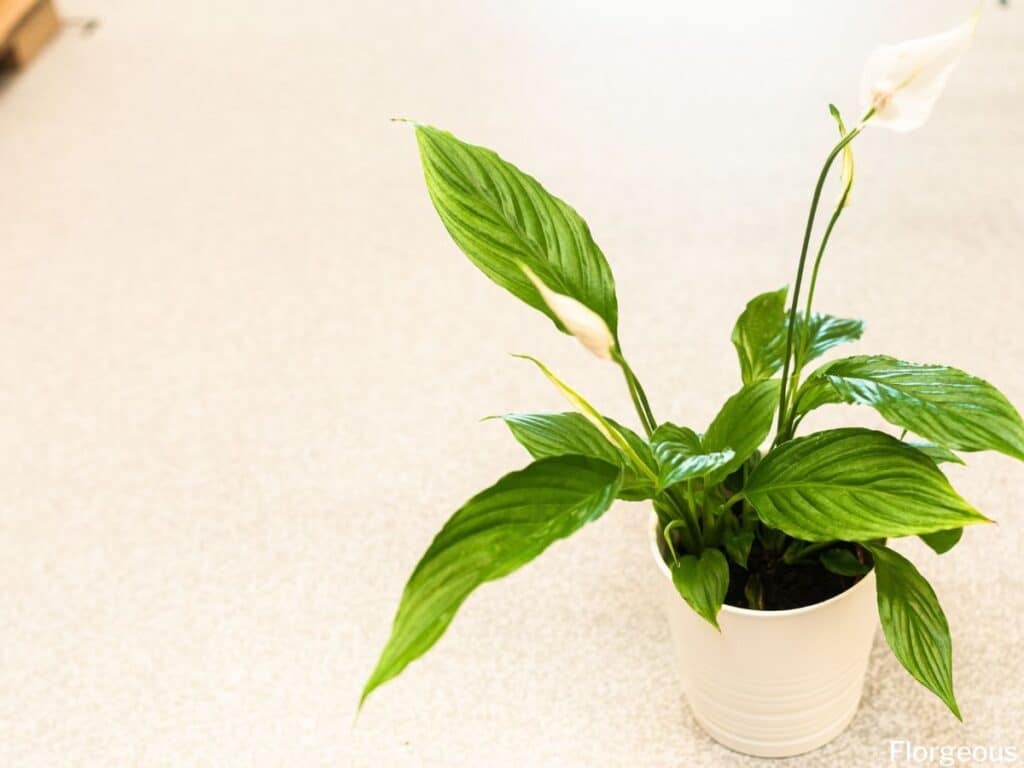The peace lily is not a stranger to avid gardeners and plant collectors. This member of the Araceae family is well known not just for adding a tropical vibe to your home but also for purifying the air you breathe.
NASA has found this plant to be on the top list for removing toxic air pollutants such as benzene, formaldehyde, and carbon monoxide while replacing them with clean and fresh oxygen.
As a houseplant, it is easy to grow peace lily plants and is very suitable for beginners. It can thrive under low light conditions especially if you want to maximize the dark green color of the foliage. But if you are more after its blooms, you must put it in a place where it can receive bright indirect light.
Why is it called peace lily?
The common name “Peace lily” is used for its white lily-like blooms. Although referring not actually to the flower but the spathe, it is often associated with peace, sympathy, purity, innocence, tranquility, and prosperity.
Most peace lilies are known for their white spathes. The spathe of white flowers is also associated with the white flag, which is a symbol of a ceasefire or truce. Other common names for Spathiphyllum spp. are white sails and spathe flowers.
It is a popular houseplant recommended by Feng shui experts to grow inside homes and workplaces because it is believed to harness positive energy and remove tensions. The flower is also a staple piece of floral arrangements found in funeral services across the globe.
You can learn more about peace lily meaning on our blog.
Where can you find peace lilies in the wild?
The tranquil plant grows on floors of humid tropical forests or nearby streams in Southeast Asia, Central, and South America. It is found under canopies that receive partial or dappled light all day. The temperature on the average ranges from 20 to 29 degrees Celsius and the soil pH is slightly acidic at 5.8 to 6.5.
In the right environment, some species can grow up to 6 feet. But as a typical indoor plant, it can only reach up to 2 to 3 feet tall.

What makes the best potting soil for peace lily?
A part of making the plant healthy is a good growing substrate. Jungle soils are heavily mulched by leaves, twigs, and other debris. This characteristic of forest floors makes your own soil consistently warm and moist.
Furthermore, the decomposition of these organic materials provides a pool of nutrients for plant uptake. The high organic matter also conditions the soil and promotes the formation of aggregates that improves drainage.
Simulating the features of forest floors for peace lilies grown in containers, these tropical plants will absolutely love potting soils that are chunky and well-draining yet able to retain as much water and nutrients.
The peace lily is also a member of the genus Spathiphyllum with over 40 species. This scientifically classifies the plant, not as a lily but as an aroid. Its growing requirement is similar to Monsteras, Pothos, Philodendrons, Aglaonemas, and the like.
Thus, when it comes to choosing the best soil for peace lily, a potting mix intended for aroid plants is ideal which generally contains the following ingredients:
| Ingredient | Purpose | Proportion* | Alternative |
|---|---|---|---|
| Peat moss | Holds water and nutrients that will be later on absorbed by the roots | 40-50% | Coconut coir, orchid bark, sawdust, wood fiber, compost, leaf molds |
| Perlite | Used primarily to aerate potting mix while also able to hold some water between its air spaces | 5-10% | Vermiculite, pumice, rice hull, horticultural grit, pea gravel, calcined clay, sand, expanded clay pebbles |
| Bark chips | Helps loosen the soil and prevents sinking of the mix after watering; improves aeration and drainage; becomes organic matter once decomposed over time | 30-40% | Leaves clippings, wood fiber, pine needles, cacao bean hulls |
| Compost | Source of nutrients for plant growth; improves aggregation of potting soil; conditions the soil mix | 10-20% | Decomposed horse or carabao manure, vermicompost, worm castings |
*Varies depending on growing peace lilies conditions of the location and gardening activities
When should I repot my peace lily?
The best time for repotting peace lilies is during spring when it is undergoing an active growth phase. Otherwise, the chances of survival decrease. But please do not wait for springtime if your plant already has the following:
- Roots that are protruding out of the drainage holes
- Roots become root bound
- Potting soil has a foul odor
- Potting soil becomes degraded and compacted
How to repot peace lily?
- Select a pot or container that is slightly larger than the previous. Containers that are too large retain more moisture which can be too much for the peace lily plants and can cause root rot. Make sure it has drainage holes at the bottom.
- Water generously your plant a day or two prior to repotting. This will ease the process and reduce any stress and damage it can cause.
- Fill about ⅓ of the pot with new and fresh peace lily’s soil.
- Gently pull out the plant from the previous pot. Make sure to hold the stem near the soil surface. You can use an old knife to scrape the edge and loosen the root ball. Be careful to avoid root damage.
- Inspect the roots. Remove any brown or black roots by using sharp scissors.
- Plant peace lily inside the new container. Make sure to adjust the position to look nice. If it is too deep, you can add more soil below.
- Fill the container with the remaining potting soil. Gently press the surface with your fingers.
- Water the plant thoroughly to stabilize the gaps between the roots and the soil mix. By this time, the potting soil will tend to sink. You can add more to fill the pot.
- After repotting, your plant will remain droopy or even lose some leaves because of the shock. Place it in a shaded area and avoid moving your plant or applying fertilizer within days or weeks. Water and take care of your peace lily plant the same way you did before. The development of new roots is a sign that it is recovering well.
FAQs
Do peace lilies need acidic soil?
Yes, peace lilies prefer slightly acidic soil, with a pH range between 6.0 and 6.5.
Can I use cactus soil for peace lily?
No, cactus soil is not ideal for peace lilies, as it is too well-draining and lacks organic matter. Peace lilies grow best in a well-balanced potting mix with good drainage.
Should I use perlite for peace lily?
Yes, perlite can be added to the potting mix for peace lilies to improve aeration and drainage, which can help prevent waterlogging and root rot.
Final thoughts
In conclusion, selecting the right soil for peace lily care is crucial for ensuring their health and vitality.
A peat-based, well drained potting mix with perlite or sand is a good choice, providing the necessary balance of moisture retention and aeration. Avoiding heavy or compacted soils helps prevent waterlogged conditions and root rot, allowing this easy to grow plant to thrive in their indoor environments.
By using the appropriate soil mix and maintaining proper watering practices, gardeners can enjoy lush foliage and abundant blooms from their peace lilies for years to come.
I hope this guide provides all the details you need to make the best soil for peace lilies. Explore our blog to learn more about indoor plants potting soil.
Up next:







